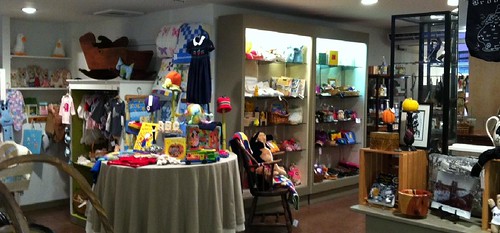For Linda Alperin, 62, each day working at the Brooklyn Women’s Exchange is a pleasant holiday. Having volunteered at the charity consignment shop for 27 years, Ms. Alperin shares its missions of sustaining American handcrafts movement and providing a means of support for needy crafters. And for her, it is just like Christmas each time a new batch of goods arrives.
“I love working here because every time I open a box, I never know what’s in there,” says Ms. Alperin. “I would go like ‘Oh my God, look at this, oh my God!’”
The exchange was founded in 1854, by a group of local women worried about the growing number of women who were finding it hard to support themselves during the volatile time in the American economy. Over the years, the shop has empowered generations of Brooklyn women by helping to sell the fruits of their labor and generate an income. During the Civil War, the Spanish-American War and World War I, women of the exchange made warm garments for soldiers.
Today, members of the Brooklyn Women’s Exchange may also be men.
“For about 15 years we’ve been having male consignors, because men walked in and said ‘I do this, can you sell it?’ says Ms. Alperin. “I even have a male knitter, and he’s fabulous.”
Hand-knitted beanies, hand-made wood-carved toys, rag dolls, mocked dresses, patched baby blankets are among countless things one can find here that invoke sweet memories of the past.
“Because nowadays most things are [mass produced in] India or China, you do lose the sense of something being made locally, something being made may be with love and care, by people who actually want to do this, not just that they have to,” says Lorna Gallagher, a new high school graduate and part-time sales assistant at the exchange. “But here, you find it!”
A not-for-profit business entity, the BWE is run mostly by volunteers. Last year, the shop had a sales volume of $236,000, of which it kept 30 percent to cover basic operating costs. The rest 70 percent went back to BWE’s 250 consignors, many of whom are immigrants, elderly, handicapped or financially needy crafters.
“I get thank you notes from people for the check that they get every month,” says Ms. Alperin. “It might be just $300, but for them, it’s a big help, and they are always thanking.”
For those who do not rely on the exchange for income, the shop is still a great source of support.
“It’s important for people who do handcrafts to have somewhere where their work can be seen,” says pottery artist Barbara Cahn, who sells many of her pieces online but still consigns with the BWE. “When you sell online, people are looking at a little tiny picture, and when they come into a beautiful shop like the Brooklyn Women’s Exchange, they can feel the handcrafts, and it’s really important.”
The BWE is not alone in pursuing its missions. The exchange is joined by 18 sister groups from the Federation of Women’s Exchanges, whose common goal is to champion the cause of keeping American crafts alive and flourish. The federation meets every year to discuss issues of common interest, suggest marketing strategies, share possible new crafters, and renew old friendships.
“Federation members draw strength and enthusiasm from one another, and though our missions are fundamentally the same, no two are exactly alike,” shares FWE president Joan Ryan. “Some Exchanges give back to the communities they serve by donating their proceeds to other not-for-profits in their surrounding areas, others provide instruction for budding crafters in the form of workshops held at their shops, and still others champion the cause of sustaining American handcrafts in the U.S. by calling attention to the value of these historic arts.”
With all its efforts, the FWE has nurtured many crafters to go on with their passion and grow big.
“All exchanges help women, and some men as well these days, to help themselves by providing charming storefronts for artisans to sell their work,” says Ms. Ryan. “A number of our former crafters have gone on to starting businesses of their own, businesses that put even more Americans to work.”
The federation used to have over 100 members when it was founded almost 80 years ago. The number of exchanges has reduced significantly in the last couple of decades. Ms. Ryan attributes this to the economic downturn that make it more difficult for people to volunteer their time for free. Rising cost of running a shop, from postage, utility bills to rent, has also made it more difficult for exchanges to manage.But Ms. Ryan is confident that women’s exchanges will continue to survive.
“Exchanges will always be relevant as we do change with time,” says Ms. Ryan. “And though Exchanges do close, they also open. Our newest member, the Women’s Gift Exchange of Sherman, TX, celebrated its first birthday this September.”
Another source of encouragement for Exchanges is the high level of customer loyalty that is often not found at traditional shops. At the BWE, Brooklyn resident Katherine Gallagher keeps coming back for not only the gorgeous and unique gifts, but also the special atmosphere that she does not find at other places.
“The Brooklyn Women’s Exchange is a great neighborhood store that captures the spirit of Brooklyn Heights, and the beauty of Brooklyn Heights,” says Ms. Gallagher. “And I am impressed by the love and dedication the volunteers here have put in to keep the exchange spirit going on.”


